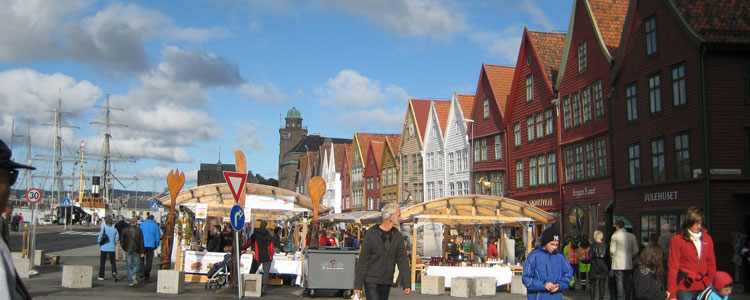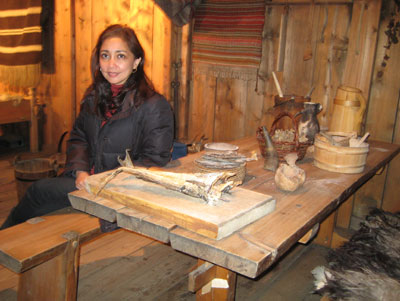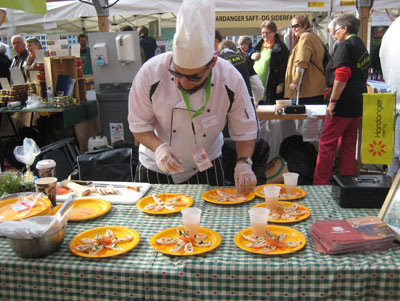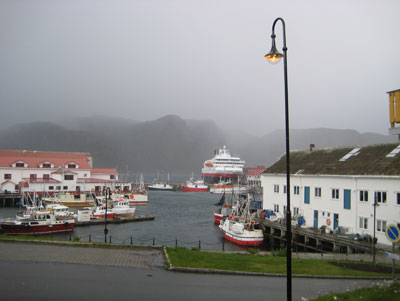Plying the waters along Norway’s western coast
by Fred Steinberg; Riverside, CT
“Let’s get one thing straight: this is not a cruise ship and this is not a cruise. This is a working commercial boat which transports everything from furniture and autos to fresh vegetables and clothing, making over 30 stops along the Norwegian coast. And there are local passengers in transit getting off and on at most every stop, so if you hear noise in the middle of the night, don’t call to complain. Go to one of the top decks and look out at what’s happening. You may find it more interesting than sleeping.”
That’s how Ina Johansen, our no-nonsense activities coordinator, greeted some 400 passengers who had boarded the Good Ship M/S Nordkapp in Bergen this past September. It was the beginning of a fascinating voyage that ended in Kirkenes, a tiny Norwegian city on the Russian border some 200 miles above the Arctic Circle.
About the trip
True, there are no history or geography lectures, pools, spas, casinos, midnight buffets, shuffleboard courts or stage shows aboard Hurtigruten Line’s Nordkapp or its 11 sister ships that daily ply the 12-day route up and down the western Norwegian coast. These all are working ships, both larger and smaller than the seven-deck Nordkapp.
All but the smallest are stabilized, but unseasoned ship passengers should still take care as to which ship and cabin they book. Anyone prone to seasickness should opt for a midship cabin.
Along the 1,250-mile route, we would view snowcapped mountains and breathtaking fjords dotted with the occasional traditional red fishing hut, many of which are refurbished for tourists. We would wander through small, active ports and tiny villages where visits to pocket museums devoted to polar region history and development, native explorers, Arctic fishing and hunting and local animals and birds were scheduled.
During our voyage, we did experience occasional rough seas but only for short periods before we would again enter a protected seaway, a narrow inlet or another port. But there is no question that skirting the Norwegian and Barents seas can be rough, especially in winter, and there is no way to accurately predict the weather much in advance, so passengers should prepare their sea legs and bring proper pills or, better, antiseasickness prescription patches.
Beginning in Bergen
We decided to spend two nights in Bergen before boarding our ship — a more-than-worthwhile experience. A small, easy-to-walk World Heritage port city near the bottom of Norway’s west coast, Bergen features cobbled streets, small wooden houses and a signature fish market.
We were lucky to be there during the annual Bergen Food Festival, which takes place over one weekend in September (dates vary). It featured a major open-air food market with a variety of local products, including condiments, jams, cheeses, sausages and numerous varieties of smoked salmon and mackerel. We picked up containers of local honey to bring home as gifts, and the honey proved to be world class.
If you’re into museums, consider spending an additional full day in Bergen, as there are some 20 galleries and museums.
And don’t miss the Leprosy Museum — really! It’s housed in an 18th-century facility that was dedicated to the research and treatment of this disease under the leadership of Dr. Armauer Hansen, who gave his name to the clinical designation for leprosy: Hansen’s disease.
Setting sail
On our second day on the water, an early-morning stop in Ålesund did not leave enough time to disembark, but we could easily view the brightly decorated Art Nouveau-style fishing village that hugged the port.
Shortly after, we diverted from the coast for a five-hour trip up and back the magnificent Geiranger fjord, a UNESCO World Heritage Site. The fjord’s deep-blue waters are fed by towering waterfalls cascading from the surrounding snow-covered mountains. The lush, green vegetation of the mountains is dotted with occasional houses and farms, many sitting halfway up their 4,000-foot peaks. We wondered how the occupants could possibly access civilization.
Each day thereafter, in addition to making many brief stops — only some of which left sufficient time for even a short walk around the dock area — the ship would make three- or four-hour stops for tours of a city and the nearby area. However, I would suggest, unless you have trouble walking, that you avoid the city tours, as even the shortest cost $60 and over and you can easily walk these streets and access nearby sites with convenient public buses.
Seasonal snowmobile, dogsled and river-rafting excursions are of great interest to the more adventurous, but they are even more expensive. The snowmobiling trip in Lapland offered on our trip, for example, cost almost $400.
On day three we made a six-hour stop in Trondheim, Norway’s first capital. This small city features the unique Ringve Museum of music history; the impressive Nidaros Cathedral; an Old Town with quaint wooden buildings, and a summer open-air folk museum.
We crossed the Arctic Circle on day four, and late that afternoon the passengers were called by Ms. Johansen to the ship’s starboard side to view the Seven Sisters Falls, whose braids descend the mountains to form a dramatic frothy bridal train.
Some bad, some good
Being a foodie, my wife opted for the “Viking Feast” side trip, which turned out to be the biggest mistake of the trip. This 2½-hour excursion consisted of a 60-minute bus ride to the so-called Lofotr Viking Museum followed by a half-hour meal consisting of a single plate of tasty sliced lamb, vegetables and bread and a glass of overly sweet honey rice wine, then 20 minutes in the gift shop. All this for only $120 per person! If this was what the Vikings “feasted” on, no wonder they were into plunder and pillage.
The following day we visited Tromsø, the launching point for most polar expeditions. Its Arctic Cathedral is a modern architectural gem featuring a huge glass mosaic of images and symbols, and the Polar Museum, located in a Customs house almost 200 years old, features exhibits of polar history.
Our last full day on the voyage found us in Honningsvåg, the gateway to the North Cape. Rising almost vertically over 1,000 feet above the Arctic Ocean, the Cape is often referred to as the northernmost point of Europe (though, technically, it’s not).
Tours were available to the Cape for $120 per person, but a good number of passengers opted for the 3½-hour “Bird Watching Safari” ($185). Some 50 species of birds ply the Arctic. Depending upon the season, they include puffins, sea eagles, razorbills, northern gannets, cormorants and kittiwakes.
Honningsvåg, itself, features the North Cape Museum, where exhibits depict the history of the area with a focus on hunting and fishing. Another highlight is the Honningsåg Church. Built in 1884, it was the only building left standing after the Nazis razed the town in 1944.
In order to make our midday flight back to Oslo, we did not have any time in Kirkenes, where Hurtigruten ships turn and head back for the six-day return trip to Bergen.
Voyage rates vary depending on season, cabin and ship, ranging from as low as $1,205 per person, double occupancy (inside lower cabin), to over $8,000 per person for suites on one-way trips. Twelve-day round trips run about 30% more. Half-price deals are occasionally available in the shoulder and winter seasons, and early-booking discounts are also offered on occasion.
For our seven-day voyage north from Bergen to Kirkenes, the two of us paid $2,500 for a twin cabin. Included were three meals per day.
Prices in Norway are very high, and ship prices, of course, are inflated. Coffee and tea cost $4, outside of meals, with beer $8 and wine by the glass $11. A bottle of wine will set you back $50 and up, though a nightly wine plan can reduce that $35. It’s best to buy wine in port, where a good Spanish or French red can be had for $20 to $25. There is also, ridiculously, a pitcher price of $4 for water at dinner.
Reservations can be made through a number of authorized agencies, directly through Hurtigruten (www.hurtigruten.com) or its friendly Estonian reservation center (800/323-7436). At the time of our booking in August ’09, the center was relatively new and we occasionally found that our agent was working from information that was not completely up to date, so check details carefully before confirming.
As our SAS plane to Oslo rose from Kirkenes and we slowly ascended from the dramatic Arctic coast, I was reminded of the words of President Teddy Roosevelt when he delivered his 1903 speech at the Grand Canyon: “Leave it as it is…. the ages have been at work on it and man can only mar it.”




